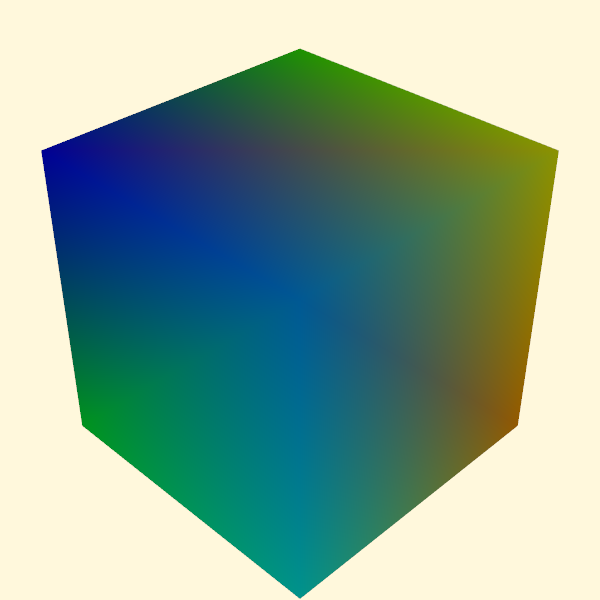Cube
vtk-examples/Python/GeometricObjects/Cube
Description¶
This is based on the C++ example Examples/DataManipulation/Cxx/Cube.cxx in the VTK source distribution.
It illustrates the manual use of vtkPolyData to construct a cube and differs from the Wiki examples Cube1.cxx and Cube1.py, which use vtkCubeSource.
Question
If you have a question about this example, please use the VTK Discourse Forum
Code¶
Cube.py
#!/usr/bin/env python
"""
This is (almost) a direct C++ to Python transliteration of
<VTK-root>/Examples/DataManipulation/Cxx/Cube.cxx from the VTK
source distribution, which "shows how to manually create vtkPolyData"
A convenience function, mkVtkIdList(), has been added and one if/else
so the example also works in version 6 or later.
If your VTK version is 5.x then remove the line: colors = vtkNamedColors()
and replace the set background parameters with (1.0, 0.9688, 0.8594)
"""
# noinspection PyUnresolvedReferences
import vtkmodules.vtkInteractionStyle
# noinspection PyUnresolvedReferences
import vtkmodules.vtkRenderingOpenGL2
from vtkmodules.vtkCommonColor import vtkNamedColors
from vtkmodules.vtkCommonCore import (
vtkFloatArray,
vtkIdList,
vtkPoints
)
from vtkmodules.vtkCommonDataModel import (
vtkCellArray,
vtkPolyData
)
from vtkmodules.vtkRenderingCore import (
vtkActor,
vtkCamera,
vtkPolyDataMapper,
vtkRenderWindow,
vtkRenderWindowInteractor,
vtkRenderer
)
def mkVtkIdList(it):
"""
Makes a vtkIdList from a Python iterable. I'm kinda surprised that
this is necessary, since I assumed that this kind of thing would
have been built into the wrapper and happen transparently, but it
seems not.
:param it: A python iterable.
:return: A vtkIdList
"""
vil = vtkIdList()
for i in it:
vil.InsertNextId(int(i))
return vil
def main():
colors = vtkNamedColors()
# x = array of 8 3-tuples of float representing the vertices of a cube:
x = [(0.0, 0.0, 0.0), (1.0, 0.0, 0.0), (1.0, 1.0, 0.0), (0.0, 1.0, 0.0),
(0.0, 0.0, 1.0), (1.0, 0.0, 1.0), (1.0, 1.0, 1.0), (0.0, 1.0, 1.0)]
# pts = array of 6 4-tuples of vtkIdType (int) representing the faces
# of the cube in terms of the above vertices
pts = [(0, 3, 2, 1), (4, 5, 6, 7), (0, 1, 5, 4),
(1, 2, 6, 5), (2, 3, 7, 6), (3, 0, 4, 7)]
# We'll create the building blocks of polydata including data attributes.
cube = vtkPolyData()
points = vtkPoints()
polys = vtkCellArray()
scalars = vtkFloatArray()
# Load the point, cell, and data attributes.
for i, xi in enumerate(x):
points.InsertPoint(i, xi)
for pt in pts:
polys.InsertNextCell(mkVtkIdList(pt))
for i, _ in enumerate(x):
scalars.InsertTuple1(i, i)
# We now assign the pieces to the vtkPolyData.
cube.SetPoints(points)
cube.SetPolys(polys)
cube.GetPointData().SetScalars(scalars)
# Now we'll look at it.
cubeMapper = vtkPolyDataMapper()
cubeMapper.SetInputData(cube)
cubeMapper.SetScalarRange(cube.GetScalarRange())
cubeActor = vtkActor()
cubeActor.SetMapper(cubeMapper)
# The usual rendering stuff.
camera = vtkCamera()
camera.SetPosition(1, 1, 1)
camera.SetFocalPoint(0, 0, 0)
renderer = vtkRenderer()
renWin = vtkRenderWindow()
renWin.AddRenderer(renderer)
iren = vtkRenderWindowInteractor()
iren.SetRenderWindow(renWin)
renderer.AddActor(cubeActor)
renderer.SetActiveCamera(camera)
renderer.ResetCamera()
renderer.SetBackground(colors.GetColor3d("Cornsilk"))
renWin.SetSize(600, 600)
renWin.SetWindowName("Cube")
# interact with data
renWin.Render()
iren.Start()
if __name__ == "__main__":
main()
